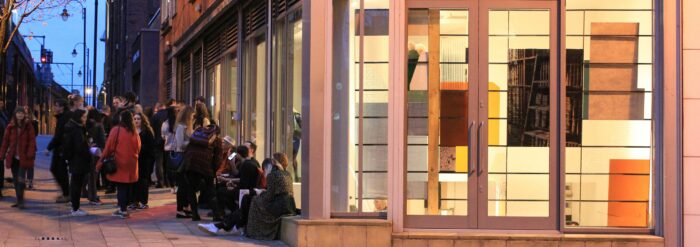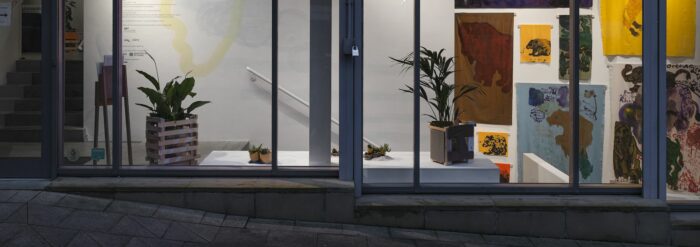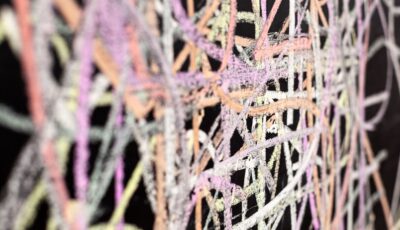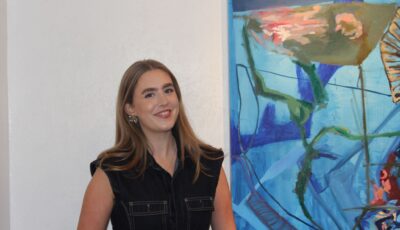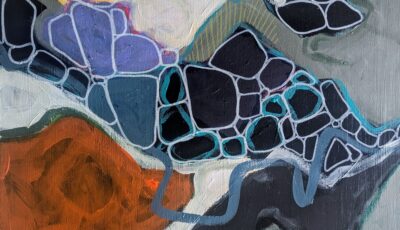Spotlight: Artists and Sustainability – Rowland Hill
Posted on 21 February 2024
This month we’ve invited Rowland Hill to contribute to our ongoing series Spotlight – Artists and Sustainability, where we ask artists to share short responses about their work and how it might relate to climate change.
Rowland Hill creates experiences that play with the artifice, tension and vulnerability inherent to live performance and its stagecraft, sometimes with an unsettling or ambivalent outcome. She frequently works collaboratively and across a range of media, especially film and video, live performance, installation, sound, collage and experimental event formats.
Logical Song, her first major solo exhibition, continues at Castlefield Gallery until Sunday 3 March 2024.
In what ways do you feel your work might relate to issues of climate change and sustainability, in the content of the work, its narrative, conceptually or theoretically? How might it speak to or challenge public discourse?
I generally consider all of my work across a variety of disciplines to be a form of collaging, which is inherently a practice concerned with repurposing and re-contextualising existing material. For example, I make paper collages which incorporate found imagery stuck onto board which I cut myself with a mount cutter, so the whole process is very cheap and nothing is wasted.
In general, I am interested in allowing room for ambiguity, speculation and doubt. In terms of subject matter, my work often gets at things indirectly. Logical Song, my exhibition at Castlefield, contains a pseudo club space, Fluchtpunkt, which features submerged techno beats, isolated trance vocals and field recordings of extreme weather; a recurring metaphor in 1990s Eurodance music for conflict and resolution. These weather sounds—torrential rain, lightning, tornados—have the potential to take on a stark significance in the context of today’s climate catastrophe. My approach was to present this material as literal background noise: the subtext to a show full of other bad omens and warning signs that are possible to overlook amongst its shiny surfaces, beguiling fairground paraphernalia and the exaggerated anticipation of entertainment. I hoped this approach might capture something of the fantasy world of Eurodance music and its disquieting rhetoric of utopia and disaster.
With regards to the materials, processes and techniques you use to produce your work, are there any practical decisions you make with regards climate change and sustainability?
I’ve worked in event curating and producing for at least 10 years, which, alongside my practice, has helped me accrue some experience of managing budgets and resources of varying scales, often small, and working with various restrictions. I’ve learnt to be inventive and resourceful, which often amounts to working well with local people to share knowledge and resources; being reliable and a good communicator; and putting the energy and commitment in. Creating and investing in community around us is paramount to sustainability of all kinds.
When working on any project it helps to prepare as much as possible to avoid unnecessary expense and waste. There is a certain conflict here for me, in that I generally believe there is significant value in trying to figure out what I’m making through the process of making, and so often ideas can come last minute. I have found that a good tactic for this is to be aware of limitations and to work with them. If I’m working on a commission, I will want to intimately study the space I’m presenting in to understand all of its various logistical and experiential qualities, all of which set immediate restrictions. I don’t think putting arbitrary limitations on a project is a bad idea either – myself and artist Darren Nixon publish 1 minute videos on Instagram every Friday and each week it helps to know I have this specific time frame to play with. With the limitation in place, I find I can still accommodate last minute ideas.
In general, how do you feel galleries, art spaces, artworks and artists might be able to contribute, what if any role do you feel they can play in a progressive conversation?
We should all be thinking about the world around us and can all make ethical choices with our neighbourhoods, communities and environment in mind. But ultimately we rely on government and corporations to commit to making real change. From a local perspective, I’ve been despondent to see a loss of artist-led spaces in Manchester in recent years and a movement towards funding what is essentially cultural tourism and expensive, large scale touring projects. There is a place for both, and I want to see world class art in the city as much as anyone else, but the scene feels atomised at the moment and this seems intimately connected to a loss of affordable spaces and grassroots investment. If councils and funding bodies made space more accessible, this would inevitably create more potential for change and social / political momentum of all kinds.
Are there any tips or advice, anything you have learnt you might want to share with other artists or our audiences?
This might be obvious to many by now, but recalibrating expectations of what an exhibition looks like—moving away from the pristine white cube for example—seems like a good idea in many cases. Accepting used materials already at your disposal will affect the appearance of the work or environment and might not result in something that looks clean and polished, but it also will prompt you to not take any aspect of the format of presenting work as a given.
